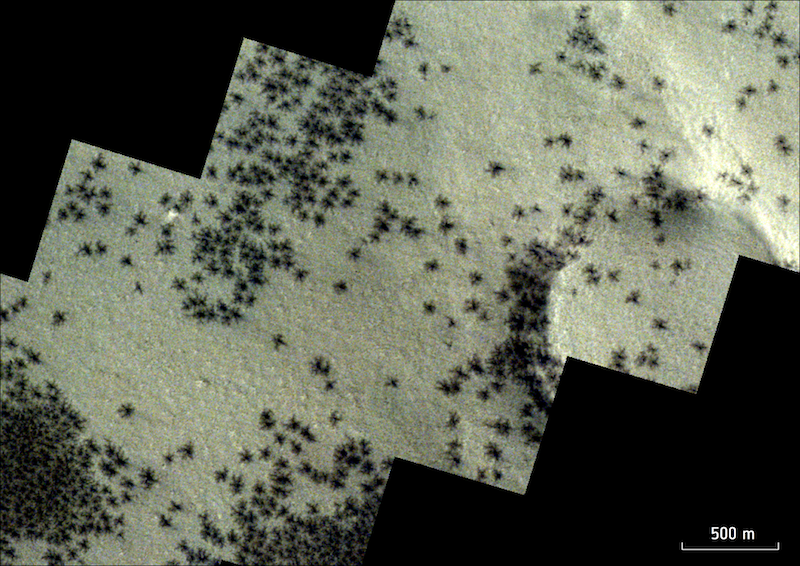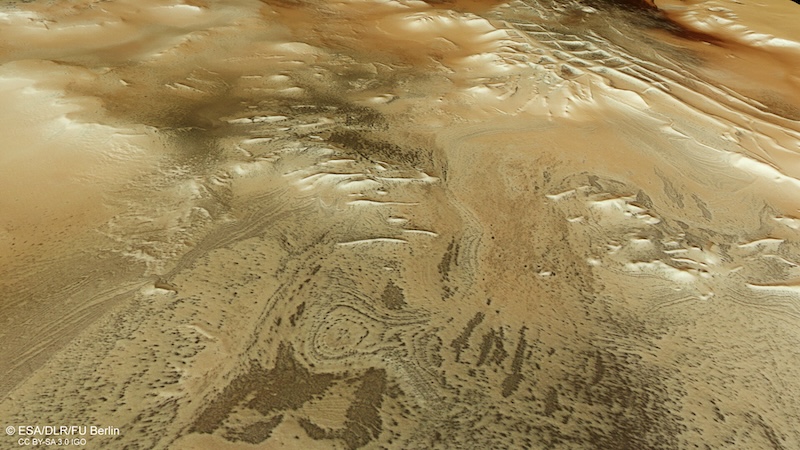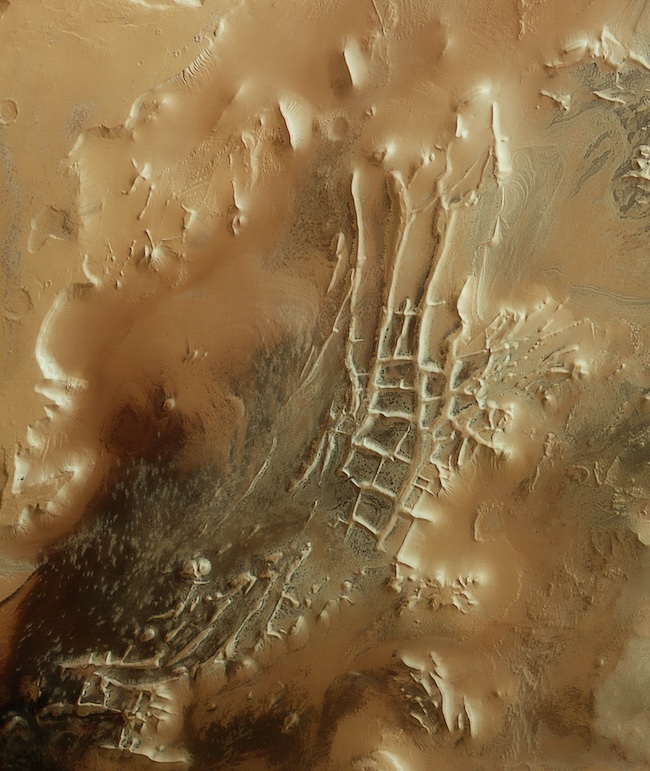
- The European Space Agency (ESA) released more images of the enigmatic, geologic “spiders” and Inca City at the South Pole of Mars.
- The Mars spiders aren’t lifeforms.. They’re dark patches resembling spiders, seen from above by spacecraft, created by geysers of carbon dioxide gas and dust, erupting through layers of ice on Mars.
- Inca City on Mars is where the spiders are found. This is scientists’ name for a series of hollows and ridges that resemble an ancient Incan ruin. This, too, is a natural geological formation, scientists say, and not made by ancient Martians.
There are spiders on Mars
Have you read about the Mars spiders? No, they’re not a creepy crawly form of life. And they have nothing to do with David Bowie’s iconic album The Rise and Fall of Ziggy Stardust and the Spiders from Mars. The Martian spiders are geologic features on the red planet’s surface. They formed by geysers of carbon dioxide gas at Mars’ South Pole. The European Space Agency’s Mars Express orbiter acquired some new images of these fascinating formations and the “city” they inhabit, which scientists call Inca City (formerly Angustus Labyrinthus). This “city” isn’t a true city and wasn’t built by ancient Martians. It’s a large network of linear and geometric ridges that resemble ancient Incan ruins. ESA released the new images on April 24, 2024.
The Martian spiders
The spiders are irregular dark shapes on the landscape that look like spiders with multiple tendril-like legs. Typically, they range from about 147 feet (45 meters) to 1/2 mile (one km) in size. When first found, they looked like they might be some form of vegetation. But closer inspection by orbiting spacecraft, however, revealed what they really are, which is still fascinating: deposits of carbon dioxide gas and dark dust that form from geyser-like eruptions.
In the Martian winter at the South Pole, carbon dioxide forms layers on the surface. And carbon dioxide in the form of ice is the lowest layer. In spring, sunshine causes the ice to turn into carbon dioxide gas. The gas gradually builds up beneath slabs of ice. Eventually, it breaks through the ice as tall geysers. The gas also contains the dark dust, which falls back onto the surface. Consequently, the spots of spray from the gas and dust look like spiders.
In addition, there are other spider-like or web-like patterns below the ice. Scientists say the same processes likely create those as well.


Martian spiders and Inca City
Most of the spiders are on the outskirts of a geological formation called Inca City. But quite a few are inside the city, too. The “city” – also formally known as Angustus Labyrinthus – is a long series of linear and geometric ridges or “walls” that are reminiscent of archaeological ruins of the ancient Incas on Earth.
But to be clear, scientists don’t think Inca City is an artificial ruin. That said, they’re not exactly sure how it formed, either. Theories include sand dunes that hardened over time to form the ridges or magma or sand seeping through fractured bedrock. Or the ridges might be eskers, that is, long, winding ridges of stratified sand and gravel, which occur in glaciated and formerly glaciated regions of Europe and North America.
An ancient impact crater?
One possible clue is the ridges appear to form part of a larger circle. That circle would be about 53 miles (85 km) in diameter and would likely be the remains of an ancient impact crater. The impact may have created faults in the surface that then filled up with lava. The faults then wore away over billions of years, leaving behind the ridges.
The landscape near Inca City features “swirling ovals.” Those also may have formed when layered deposits of material slowly wore away over time. In addition, there are flat-topped mesas and hills nearby, standing over 4,500 feet (1,400 meters) tall.
While the spiders and city don’t really have anything to do with Martians – living or dead – they are a fascinating glimpse at some of the geological processes on the red planet. Mars is full of surprises!
Bottom line: Martian spiders? Inca City? Both geologic features on Mars. The European Space Agency (ESA) just released new images of them. Take a look!











